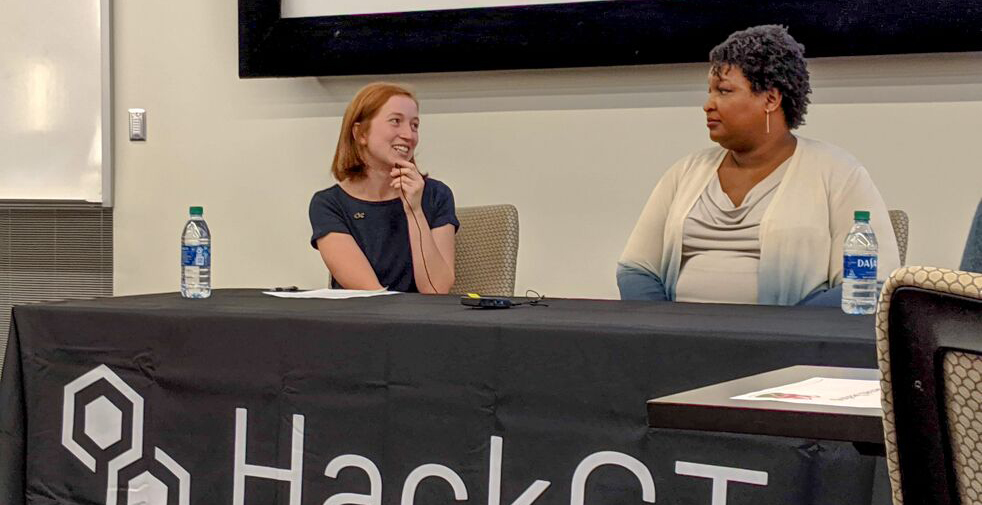
On Monday, Nov. 4, student counter-protestors flocked to the designated free speech corner next to the student center to block signs purportedly visualizing the aftermath of abortions. An auxiliary sign near the Campanile intended to contextualize the signs read “Abortion victim photos ahead.”
Created Equal, an anti-abortion advocacy organization from Columbus, Ohio, set up the signs early in the morning, along with an electronic marquee in front of the amphitheater. Passing students may have received Created Equal’s pamphlets, which are adorned with a quote from Dr. Martin Luther King, Jr., and the statement “Abortion is ageism.”
When asked, Created Equal’s onhand media liaison described the group as “a humans’ rights organization,” and stated their reasoning for coming on campus: “We believe that we need to show the truth of what abortion is doing. It is disgusting, and it is horrific. These images are very gruesome to look at. That’s because that’s what abortion is. It’s killing innocent human beings. And so we have to display it. We have to stand up for the victims and show what is actually being done behind closed doors thousands of times every single day.”
She added that Created Equal planned to bring their message to other Ga. universities, specifically Kennesaw State University and the University of Georgia. As of Nov. 6, these events have yet to occur.
Since the signs were set up on a busy campus thoroughfare, many students saw the signs and decided to launch an impromptu counter-protest. Posters with pro-abortion rights slogans abounded around the intersection. Many were written in marker on white poster, though some were printed and even mounted on salvaged cardboard. Some students gave vocal warnings to passersby about the upcoming photos.
Two students claimed to have left class early to hold signs near the Ferst Center parking lot. “We saw them [the signs], we messaged each other, we made signs, we came out.”
Jacob Skovran, second-year ME, and Sawyer Flanagan, second-year AE, appeared shortly before 2 p.m. holding a sign reading, “OK Boomer.” Pictures of the sign, which the holders planned with Drake Witt, second-year CS, circulated over social media. The slogan has recently become a popular retort to espoused ideas associated with older generations, specifically Baby Boomers and occasionally Gen-Xers.
The Young Democratic Socialists of America (YDSA) also attended the counter-protests. One member commented on the nature of the counter-protests, saying, “A couple of our members saw that this was happening this morning, so we just rounded up a couple people to go out with signs. We just sort of got out here initially, and then a bunch of unaffiliated students just joined on in … There’s been an overwhelming student opposition to this because it’s clearly inappropriate, these are clearly fake photos, and [members of Created Equal] are not actual students at all … We’re
not engaging with them, we’re just vocally demonstrating that the students of Georgia Tech are overwhelmingly pro-choice, overwhelmingly in favor of womens’ right to abortion … We’re not here to confront them, we’re here to show the real student opinion.”
Another YDSA member said of Created Equal’s presence in the designated free speech area, “I respect that they have the right to say what they want to say, but this stuff, with the gore and the guts, this is clearly just to shock people, especially women who have had to deal with having an abortion for medical reasons or had a miscarriage… I think there are civilized ways to state your opinion.”
At their Nov. 5 meeting, SGA drafted a resolution regarding their opinion on the setup, which passed that same evening. On Nov. 6, they posted this statement on their Facebook page: “The imagery and graphic content display on campus this past Monday was distressful, and the effects which they may cause on students are insurmountable. As a campus, we must stand united in the face of physically and emotionally damaging content that disrupts our campus. Georgia Tech is strong, and it is because of our students that we will move forward stronger than before.” The full resolution and statement are accessible at facebook.com/GTSGA.









